Geckeler K.E., Nishide H. (Eds.) Advanced Nanomaterials
Подождите немного. Документ загружается.


17.8 New Structural Integrity Method 579
Table 17.4 Weibull modulus ( m ) and shape parameter ( β ) of ball - grind
alumna composites containing 20 vol% of S i C whiskers.
Sample type Weibull modulus,
m (MPa)
Shape parameter
( β )
Machined specimen 6.69 549
Machined specimen healed at 1573 K for 1 h 6.70 796
Machined specimen healed at 1673 K for 10 h 11.5 1026
Healed (1573 K for 1 h) smooth specimen 8.15 1075
1673 K for more than 10 h is required to attain the complete strength recovery for
the machined alumina/20 vol% SiC whiskers composite. This behavior can be
clearly understood by the statistical analysis using the two - parameter Weibull
function given by Equation (17.5) . Table 17.4 shows the Weibull modulus and the
shape parameter evaluated from the analyses. The values of m and β of the
machined specimen healed at 1673 K for 10 h were 11.5 and 1026 MPa, respec-
tively. The values were almost equal to those of complete crack - healed specimen.
From this statistical and χ
2
analysis, it was found that the cracks introduced by
machining were completely healed by the crack healing process at 1673 K for 10 h.
On the other hand, the machined specimen healed at 1573 K for 1 h had lower
values of m and β than those of the smooth specimen healed; thus, it can be con-
cluded that this crack - healing condition is inadequate. Two approaches are con-
fi rmed to be reasonable to explain this difference: (i) the difference in the state of
the subsurface residual stress associated with the different crack geometries and
(ii) the oxidation of SiC by the heat generation during the machining. The machin-
ing crack was closed by the action of the compressive residual stress resulting in
a redaction in the supply of oxygen to the crack walls. Moreover, before the crack -
healing treatment, if SiC particles were already covered with a thin oxidation layer,
by the grinding heat, this would lead to the decrease in the oxidation activity of
the SiC particles.
Furthermore, it was found that the various cracks initiated by machining into
various machined fi gurations could be healed by crack - healing treatment at 1673 K
for 10 h, as shown in Figure 17.24 [53] .
17.8
New Structural Integrity Method
17.8.1
Outline
A combination of the crack healing and the proof testing ultimately guarantees
the structural integrity of the ceramic components. As mentioned above, by
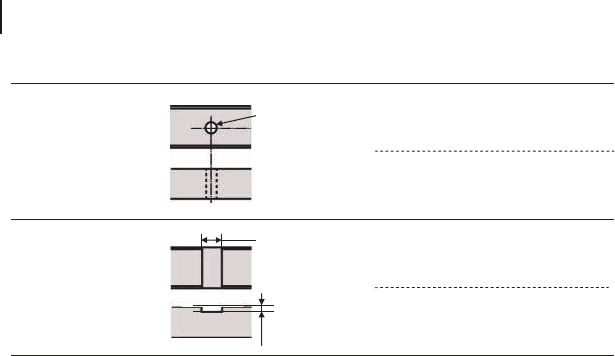
580 17 Self-healing of Surface Cracks in Structural Ceramics
eliminating not only the cracks introduced during manufacturing but also the
cracks introduced during service, the crack healing can ensure perfectly against
risk of the fracture initiated from surface fl aws. The proof testing, in which com-
ponents are over - stressed print to use, can determine the maximum critical size
of embedded fl aws associated with fracture. Embedded fl aws, such as voids, may
be present in a material as a result of the processing, and could not be generated
during service. Therefore, the minimum fracture stress caused by the embedded
fl aws [55, 56] or probabilistic fatigue S – N curves [57 – 59] has been estimated from
the proof testing stress on the basis of the linear fracture mechanics.
However, two important points must be taken account of while using the
proof testing. First is to ensure that engineering ceramics show the nonlinear
fracture behavior [60, 61] . The other is that the evaluated minimum fracture
stress is valid only at the proof testing temperature. Therefore, if ceramic compo-
nents are used at high temperature, the proof testing must be conducted at
the operating temperature. Ando et al. [62] proposed a theory to evaluate the tem-
perature dependence of the guaranteed (minimum) fracture stress of a proof
tested sample based on nonlinear fracture mechanics. This approach allows the
ceramic components proof tested at room temperature to operate at the arbitrary
temperatures.
17.8.2
Theory
On the basis of the process zone size failure criterion, the minimum fracture stress
at high temperature can be guaranteed from the proof testing stress at room tem-
perature, The criterion proposed by Ando et al. [62] has been obtained by the size
of process zone, which is the plastic deformation region at the crack tip, well
Through hole
Square groove
f 2 mm
Width = 2 mm
Depth = 0.5 mm
Means nominal
fracture stress
Machined
458 MPa
Machined healed
728 MPa
Machined
250 MPa
Machined healed
728 MPa
Figure 17.24 Effect of crack - healing condition on strength
recoveries of various machined specimens.

17.8 New Structural Integrity Method 581
expressing the nonlinear fracture behavior of ceramics. From the criterion, the
process zone size at fracture D
C
, is given by the following equation:
D
K
a
C
IC
e
C
=
⎛
⎝
⎞
⎠
=
⎛
⎝
⎞
⎠
−
{}
π
σ
πσ
σ
82
1
0
2
0
sec
(17.9)
where σ
C
and σ
0
are the fracture stress at the fracture caused by the fl aws having
a
c
and the fracture strength of the plain specimen (intrinsic bending strength),
respectively. K
IC
plane strain fracture toughness and a
c
, equivalent crack length,
which is given by the equation as
Ka
CC e
=
σπ
(17.10)
By expanding Equation 17.9 around a
c
, one can write the equivalent crack size
of the fl aws associated with fracture as shown in the following equation:
a
K
e
IC C
=
⎛
⎝
⎞
⎠
⎛
⎝
⎞
⎠
−
{}
−
π
σ
πσ
σ
82
1
0
2
0
1
sec
(17.11)
Since K
IC
and σ
0
is the function of temperature, the fracture strength associated
with a
e
needs to be also expressed as a function of temperature:
σ
σ
π
π
σ
C
e
IC
T
TT
T
a
K
=
⎛
⎝
⎜
⎞
⎠
⎟
+
⎧
⎨
⎩
⎫
⎬
⎭
−
2
8
1
1
0
0
2
1
arccos (17.12)
where the superscript T is the value at elevated temperature.
The maximum size of the fl aw. a
e
p
, that is able to present in the sample proof
tested under σ
p
, at room temperature can be given by
a
K
e
p
IC
R
R
p
R
=
⎛
⎝
⎜
⎞
⎠
⎟
⎛
⎝
⎞
⎠
−
{}
−
π
σ
πσ
σ
82
1
0
2
0
1
sec (17.13)
where the superscript R is the value at room temperature. Assuming that the sizes
of the residual embedded fl aws do not vary with change in the temperature, one
can determine the minimum fracture stress guaranteed of the proof tested sample,
σ
G
, as the fracture strength associated with a
e
p
at arbitrary temperatures. Thus the
value of σ
G
can be expressed as
σ
σ
π
σ
σ
πσ
σ
G
IC
T
IC
R
R
p
R
=
⎛
⎝
⎜
⎞
⎠
⎟
⎛
⎝
⎜
⎞
⎠
⎟
⎛
⎝
⎞
⎠
−
2
2
1
0
2
0
0
2
0
T
T
K
K
arccos sec
{{}
+
⎧
⎨
⎩
⎫
⎬
⎭
−
1
1
(17.14)
and can be evaluated from the data on the temperature dependences of K
IC
and σ
0
.
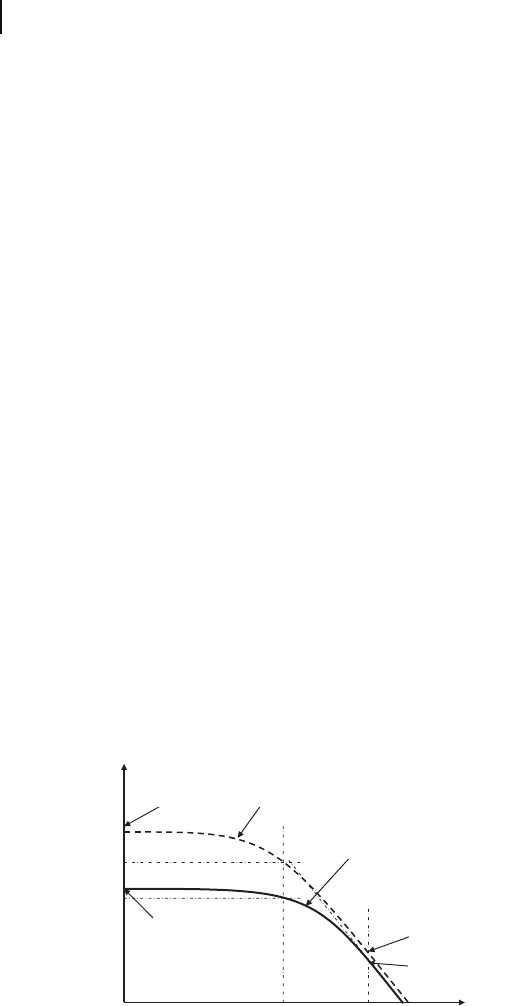
582 17 Self-healing of Surface Cracks in Structural Ceramics
17.8.3
Temperature Dependence of the Minimum Fracture Stress Guaranteed
Using the above theory, one can estimate the minimum fracture stresses at
elevated temperatures for the sample proof tested at room temperature. Ono et al.
[49] (evaluated the temperature dependence of σ
G
for alumina/20 vol% SiC parti-
cles composite. Moreover, by comparing the evaluated σ
G
with the measured
fracture stress of the proof tested sample at elevated temperature, the validity of
this estimation was given by them. Their results and discussion are presented in
the following text.
Before discussing the temperature dependence of σ
G
, temperature dependences
of the plane strain fracture toughness, K
IC
, and the intrinsic bending strength, σ
0
,
are noticed. Ono et al. [49] investigated these temperature dependences for
alumina/20 vol% SiC particles composite. The σ
0
, which is determined as the
average fracture stress of 5% of the highest strengths of the crack - healed speci-
mens at the temperatures, has large temperature dependence and the tendency is
almost linear and negative up to 1373 K. Moreover, the K
IC
is almost constant
against temperature. The features affect the correlativeness between the fracture
stresses as a function of the equivalent crack length, a
e
, at room temperature and
at high temperature. The schematic is shown in Figure 17.25 .
The fracture stress associated with small fl aw, that is, a
e
is low, is equal to the
σ
0
, and varies considerably as temperature varies. On the other hand, the fracture
stress associated with large fl aw, that is, a
e
, is high, is determined by linear fracture
mechanics as expressed by Equation (17.10) and changes scarcely with tempera-
ture change. Therefore, the negative temperature gradient of the σ
G
increases with
increasing the proof testing stress,
σ
p
R
, as shown in Figure 17.26 . Since high
σ
p
R
qualifi es a
e
p
to be a low value, the negative temperature gradient of the σ
G
becomes
considerably high. Alternatively, since low
σ
p
R
allows the large fl aws to present
Legalism of
fracture stress
Legalism of equivalent
crack length, log (a
e
)
0
log s
G
log s
p
R
log s
0
T
log s
0
R
log a
e
p
log (p
1/2
K
IC
T
)
log (p
1/2
K
IC
R
)
Room temperature
High temperature, T
Figure 17.25 Schematic illustration of proof - test theory and
the effect of equivalent crack on fracture strength at room
temperature and at high temperature.
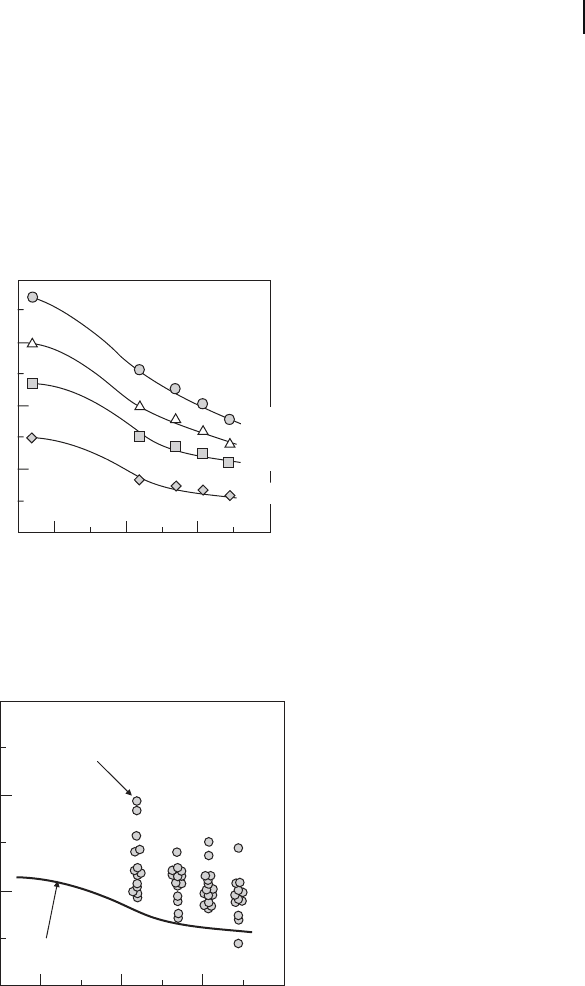
17.8 New Structural Integrity Method 583
400 800 1200 1600
Temperature (K)
200
300
400
500
600
Evaluated minimum fracture
stress guaranteed, s
G
(MPa)
s
p
R
= 570 MPa
s
p
R
= 500 MPa
s
p
R
= 350 MPa
s
p
R
= 430 MPa
Figure 17.26 Temperature dependence of minimum fracture
stress guaranteed of the proof tested under several proof
testing stress for alumina containing 20 vol% SiC particles
composite.
in the proof tested specimen, the σ
G
is almost constant as a function of
temperature.
The values of the evaluated σ
G
have good agreements with the measured
minimum fracture stress of the proof tested specimens,
σ
F
min
. Figure 17.27 shows
the data on the fracture stress of the crack - healed and the proof - tested specimens
as a function of temperature with the evaluated σ
G
for the crack - healed
alumina/20 vol% SiC particles composite when σ
p
= 435 MPa. Except the data at
1373 K, all specimens have higher strength than the σ
G
at all the temperature.
Measured fracture stress (MPa)
200
400
600
800
400 800 1200 1600
Temperature (K)
Evaluated minimum fracture
stress guaranteed, s
G
Fracture stress of the crack-healed
specimens proof tested under 435 MPa
Figure 17.27 Comparison between measured fracture stress
and the evaluated minimum fracture stress guaranteed for the
crack - heated alumina/20 vol% SiC particles composite proof
tested under 435 MPa.
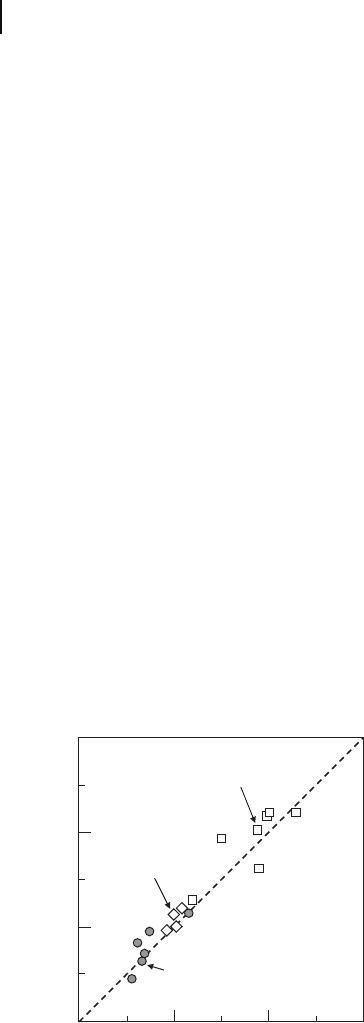
584 17 Self-healing of Surface Cracks in Structural Ceramics
Also, the minimum values of the experimental fracture stress are almost equal
to the σ
G
at all temperatures. At 1373 K, the
σ
F
min
is 6.8% less than σ
G
, but the
value exists in the dispersion evaluated from the K
IC
and the σ
0
that have large
scatters. Moreover, in the case of σ
p
= 530 MPa, the evaluated σ
G
have good agree-
ments with the
σ
F
min
as well as with all the proof - tested specimens fractured under
the tensile stress more than σ
G
. Therefore, the results well demonstrate the validity
of the guaranteed method.
Moreover, Ono et al. [49] and Ando et al. [62, 63] reported that the guaranteed
theory can be applied to different conditions and the different materials. The
obtained results can be seen in Figure 17.28 , where the measured
σ
F
min
is plotted
as a function of the evaluated σ
G
. N in the fi gure denotes the number of samples
used to obtain
σ
F
min
. Four open diamonds indicate the data on the ceramic coil
spring made of silicon nitride. Also, a open square differs from the closed circles
in the crack healing condition, that is, the open square employs 1373 K for 50 h
and the closed circle employs 1573 K for 1 h. However, all
σ
F
min
shows good agree-
ment with σ
G
. Therefore, using Equation (17.14) one can estimate the σ
G
at higher
temperatures of every material having the crack healing ability and every crack
healing condition.
On the other point of view, it is interesting whether this estimation is reversible
for temperatures, that is, the stress evaluated in Equation (17.14) can guarantee
the minimum fracture stress at room temperature of the specimen proof tested
at high temperature. For example, the σ
G
at room temperature of the
alumina/20 vol% SiC particles composite proof tested under 335 MPa (= σ
p
) at
1073 K is evaluated to be 435 MPa. Alternatively, the experimental minimum
fracture stress was 410 MPa. The σ
G
existed in the dispersion obtained from K
IC
and σ
0
, which have large scatters.
200 400 600 800
200
400
600
800
Sintered Si
3
N
4
(s
p
R
= 598 or 700 MPa)
Alumina/SiC composite
(
s
p
R
= 435 or 530 MPa)
Evaluated value, s
G
(MPa)
Measured value, s
F
min
(MPa)
Si
3
N
4
coil spring
(s
p
R
= 417 MPa)
Figure 17.28 Comparison between minimum fracture stresses
guaranteed and measured minimum fracture stress.

17.9 Advanced Self-crack Healing Ceramics 585
17.9
Advanced Self - crack Healing Ceramics
17.9.1
Multicomposite
Ceramic composite containing both SiC whiskers and SiC particles, called SiC
multicomposite , enhance fracture strength and toughness as well as endow the
ceramics with the good self - crack healing ability. As mentioned in Section 17.5 ,
the reinforcement by SiC whiskers can not only improve fracture toughness but
can also generate the self - crack healing ability. However, it is diffi cult to disperse
a large amount of SiC whiskers uniformly, and so the aggregated SiC whiskers
decreases the fracture strength. SiC multicomposits containing both whiskers
and particles improves the self - crack healing ability endowed by SiC whiskers
alone without adversely affecting the composite strength. Therefore, ceramic – SiC
multicomposites exhibit high strength, high fracture toughness, and excellent
self – crack - healing ability.
Especially, SiC multicomposites perform better than the mullite - based compos-
ites. Mullite and mullite - based composites have been expected to be advanced
ceramic spring because they exhibit the same low level elastic constant as metal
and excellent oxidation resistance. However, mullite has remarkably low fracture
toughness. Therefore, it is necessary to endow mullite with self – crack - healing
ability for actualizing mullite - based ceramic springs. The mechanical properties
of mullite/SiC composites [21, 46] and multicomposites [64] were investigated as
shown in Table 17.5 .
The fracture strength increases with SiC content increasing up to 20 vol%, above
which it remains almost constant. The fracture toughness increased with an
increase in SiC whiskers content. Clearly, it is confi rmed that crack bridging and
pulling out due to SiC whiskers lead to increase in fracture toughness. All the
Table 17.5 Mullite/ S i C composites having self - crack healing ability.
Sample descriptions Content (vol%)
Mullite SiC particle
(diameter = 0.27 μ m)
SiC whisker
(diameter = 0.8 – 1.0 μ m,
length =30 – 100 μ m)
MSI5P 85 15 0
MS15W 85 0 15
MS20W 80 0 20
MS25W 75 0 25
MS15W5P 80 5 15
MS15W10P 75 10 15
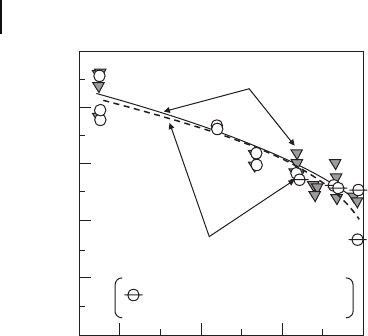
586 17 Self-healing of Surface Cracks in Structural Ceramics
mullite/SiC composites, which are listed in Table 17.5 , can exhibit a large strength
recover by the crack healing. However, mullite/15 vol% SiC whiskers composite
(MS15W) [46] cannot attain the complete strength recovery despite the optimized
crack healing condition. Complete strength recovery of the crack - healed specimens
is defi ned as the strength of the strength of the specimens, whose fracture initia-
tion is embedded fl aw. This implies the complete elimination of surface cracks
that can be attained and the strength of the crack healed part is superior to that
of the base materials. The crack healed part in mullite/25 vol% SiC whiskers com-
posite (MS25W) holds higher strength than the base materials below 1273 K, as
shown in Figure 17.29 [64] . On the other hand, the crack healed part in
mullite/15 vol% SiC whiskers/10 vol% SiC particles composite (MS15W10P) holds
higher strength than the base materials at the whole of the experimental tempera-
ture region, as shown in Figure 17.29 .
Figure 17.30 [64] shows the maximum shear strains of the mullite/SiC multi-
composites as a function of SiC content. The maximum shear strain corresponds
to the deformation ability as spring. The value of the maximum shear strain
showed a maximum at a SiC content of 20 vol%, above which it slightly decreased
because Young ’ s modulus increased with an increase in SiC content, but the
fracture strengths were almost constant above SiC content of 20 vol%. MS15W10P
has the best potential as a material for the ceramic springs used at high tempera-
tures, because it has a shear deformation ability that was almost two times greater
than monolithic mullite as well as an adequate crack healing ability.
400
800
1000
0
Flexural strength (MPa)
400 800 1200 1600
Temperature (K)
600
200
MS15W10P
MS25W
Specimens fractured
from the crack-healed zone
Figure 17.29 Temperature dependence of the crack - healed
strength of mullite/25 vol% SiC whiskers composite (MS25W)
and mullite/15 vol% SiC whiskers/10 vol% SiC particles
composite (MS15W10P), in which the center lined symbols
indicate specimens fractured from the precrack healed.
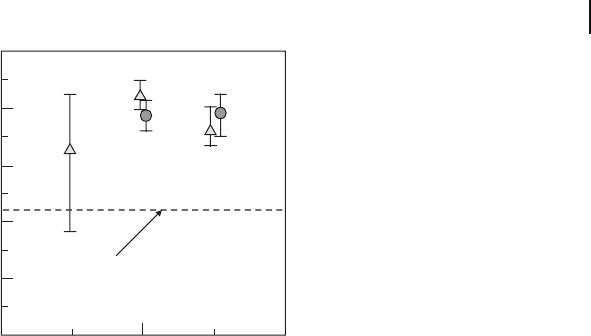
17.9 Advanced Self-crack Healing Ceramics 587
17.9.2
SiC Nanoparticle Composites
Nanometer - sized SiC fi ne particles enhance the self - crack healing rate because
it gives a large increment in the reactive area and makes the surface of SiC
particles active. This effect give a large benefi t to the self - crack healing at
relatively low temperatures at which the self - crack healing is completed in more
than 100 h.
Reaction synthesis is a promising process for directly fabricating nanocompos-
ites which are diffi cult to obtain by the normal sintering of nanometer - sized start-
ing powder compacts. Reaction synthesis to fabricate alumina – SiC nanocomposites
[65 – 71] were reported. Using the reaction synthesis (17.15)
33 2 8 6 13 6
23 2 23
Al O SiO Al C Al O SiC
()
++= +
(17.15)
Zhang et al. [71] succeeded in fabricating alumina nanometer - sized SiC particles
nanocomposite, in which the formed SiC particles are mainly entrapped inside
the alumina grains. Employing the similar process to prepare alumina – SiC nano-
composite, Nakao et al. [72] investigated the effect of nanometer - sized SiC particle
on the crack - healing behavior, as shown in Figure 17.31 .
The result demonstrates that the nanometer - sized SiC with particle size of
20 nm can signifi cantly increase the self - crack healing rate compared to the com-
mercial 270 nm SiC particles. Furthermore, the nano - SiC particles can attain the
complete strength recovery within 10 h at 1023 K, which is a 250 K lower tempera-
ture compared to the commercial SiC particles. Although nanometer - sized SiC
particles makes the crack - healing reaction activated at lower temperatures, it gives
same level of refractoriness as the alumina containing commercial SiC particles
10 20 30
0.1
0.2
0.3
0.4
0.5
SiC content (vol%)
Maximum shear strain (%)
0
MS15W
MS20W
MS15W5P
MS25W
MS15W10P
Maximum shear strain
of monolithic mullite
Figure 17.30 Maximum shear strains of mullite/SiC composites as a function of SiC content.
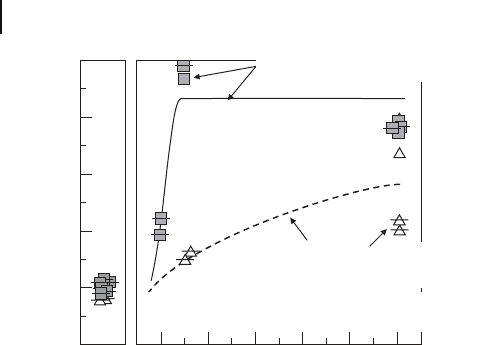
588 17 Self-healing of Surface Cracks in Structural Ceramics
composite. Therefore, it is noted that the use of SiC nanoparticles is a most valu-
able route to enhance the valid temperature region of the self crack healing.
17.10
Availability to Structural Components of the High Temperature Gas Turbine
The structural component of the high temperature gas turbine is one of the most
attractive applications for the self healing ceramics. The application requires high
temperature durability and high mechanical reliability because of its service condi-
tion consisting of high temperature and oxidizing atmosphere, which is valid
condition of the self - healing driven by the SiC oxidation. Actually the turbine
nozzle and blade of the 1500 ° C - class gas turbine are exposed in high temperatures
ranging from 1273 to 1773 K and oxygen partial pressures ranging from 8000 to
10 000 Pa. To discuss the availability of the self - healing driven by SiC oxidation to
the turbine blades and nozzles requires knowing the self healing kinetics as a
function of temperature and oxygen partial pressure, because the rate is sensitive
to temperature and oxygen partial pressure changes.
Osada et al. [39] proposed the kinetics model in which the rate of self - crack
healing, v
H
, is expressed as a function of both the healing temperature, T
H
, and
oxygen partial pressure, P
O2
. Two assumptions of the kinetic model are that the
reaction order, n , is independent on temperature and that obeying Arrhenius ’ law,
the reaction constant, k , depends on only temperature. By using the kinetic model,
k is expressed as a following function of T
H
and P
O2
;
Healing time (h)
2460
200
400
600
800
1000
0
Flexural strength (MPa)
*Center-lined symbols indicate the specimens fractured
from the precrack healed.
810
Alumina/18 vol% nanometer-
sized SiC particles composite
Alumina/15 vol% commercial
SiC particles composite
Figure 17.31 Crack - healing behavior at 1373 K on alumina
containing 18 vol% nanometer - sized SiC particles composite
and alumina containing 15 vol% commercial SiC particles
composite, in which center lined symbols indicate the
specimen fractured from the precrack healed.
